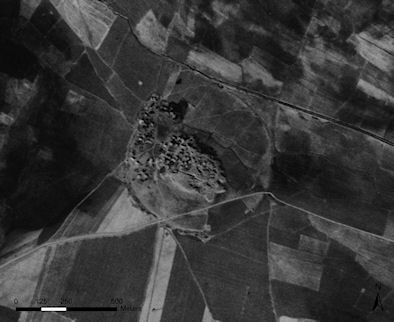
Figure 31: Zincirli Hoyuk, Islahiya Plain, southern Turkey [CORONA atlas]

Figure 31: Zincirli Hoyuk, Islahiya Plain, southern Turkey [CORONA atlas]
In addition to facilitating the rapid discovery of previously undocumented archaeological sites, CORONA imagery also enables known sites to be much better understood and interpreted, and can reveal entire areas of ancient settlement within sites that eluded discovery in the past. One notable case in which this has been possible is in the recognition of expansive fortified lower towns that sometimes surrounded more prominent mounded citadels at many ancient cities in the Near East. The early part of the Iron Age (1200-500 BC) saw a proliferation of lower towns throughout much of the northern fertile crescent. In this area, political realignments following the collapse of Late Bronze Age (1450-1200 BC) empires engendered the creation of many new capital cities, each controlling a small kingdom. Many of these new urban centres were built on top of pre-existing Bronze Age tells, but were surrounded by large, fortified lower towns (Mazzoni 1994; Bunnens 1996). Yet because older excavations in the region tended to focus their attention on the more prominent central citadels where large public buildings were more likely to be located, lower towns were typically left unexcavated and sometimes not even mapped by archaeologists. While a few new projects such as that at Zincirli Hoyuk in southern Turkey (Figure 31) are now giving Iron Age lower towns more attention (Schloen and Fink 2009; Casana and Herrmann 2010), many lower towns have now been covered by modern settlements or obscured by intensified agriculture. Fortunately, lower towns often appear with clarity on CORONA imagery, and it has thus become a critical tool in discovering and mapping these features. The size and diversity of Iron Age lower towns now visible on CORONA imagery offers an important new perspective on ancient urbanism in the Near East.
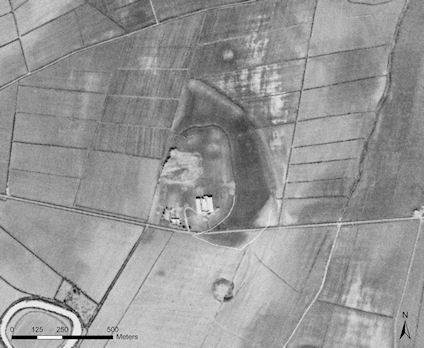
Figure 32: Tell Ta'yinat, Amuq Plain, southern Turkey [CORONA atlas]
At the Iron Age capital city of Tell Ta'yinat located in the Amuq Valley of southern Turkey, large-scale excavations undertaken by a University of Chicago team during the 1930s failed to document the existence of a massive lower town and outer fortification wall that surrounded the high mounded portion of the site. Instead, excavations focused entirely on the citadel area where temples and palaces were more likely to be discovered. One gateway in the lower town's outer wall was excavated, but the extent of the city is nowhere mapped in the publication of the project (Haines 1971). Analysis of CORONA imagery in the late 1990s immediately revealed the existence of a major lower town and fortification wall, which was subsequently mapped by surface collection (Batiuk et al. 2005), and this area has now become the focus of a current research excavation (Harrison 2009).

Figure 33: Tell Rifa'at, Qoueiq Valley, western Syria [CORONA atlas]
At Tell Rifa'at in north-west Syria, the site is dominated by a large tell rising to around 30m in height, which is today completely surrounded by a modern town. The name and location of Tell Rifa'at has led most archaeologists and historians to link it with the historically known city of Arpad, one of the most powerful kingdoms of the northern Levant during the early part of the 1st millennium BC. At that time, Arpad is known from both Neo-Assyrian sources and from the Bible as a major power in the politics of the region. The site was briefly subjected to excavations during the 1960s, although this effort focused exclusively on the top of the high mound (Seton-Williams 1961). The existence of a lower town was noted by the excavators, although neither its extent nor size was documented. On CORONA satellite imagery, this lower town appears quite clearly as a nearly perfect circle, enclosing an area of more than 80 hectares, making it one of the largest pre-Roman cities all of the Levant. The fortification wall possesses several breaks that are presumably the remains of gateways, and in one area the remains of a large rectilinear structure is visible (Casana 2012). Today this lower town is almost entirely obscured by the modern town but CORONA imagery at least enables us to map and document the previously unrecognised size of the ancient city.
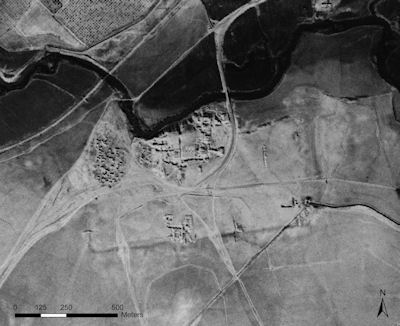
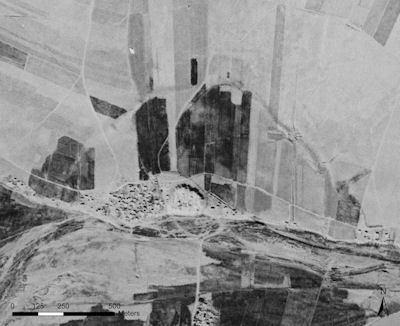
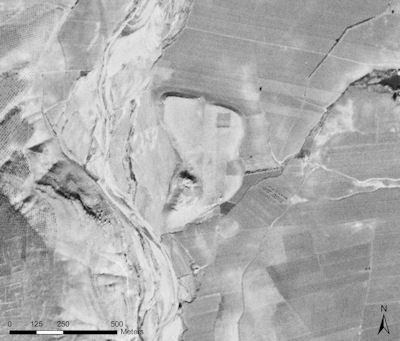
Figure 34: Tell Halaf, Khabur Basin, eastern Syria [CORONA atlas]
Figure 35: Tell Ahmar, Euphrates Valley, Syria [CORONA atlas]
Figure 36: 'Ain Dara, Afrin Valley, western Syria [CORONA atlas]
The discoveries at Tells Rifa'at and Ta'yinat are mirrored by finds at many other archaeological sites from across the northern fertile crescent. For example, the lower town at Tell Halaf forms a clear rectangle (Figure 34). Tell Ahmar (Figure 35), located along the upper Euphrates River, shows a very different, crescent-shaped plan, perhaps having been partially eroded by meandering of the river. The lower town at 'Ain Dara has an irregular shape (Figure 36).
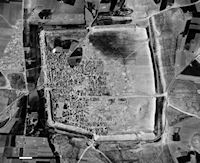
Figure 37: Tell Mishrife, near Homs, central Syria [CORONA atlas]
How these city plans relate to earlier fortified cities, such as the spectacular rectangular fortification wall at 2nd millennium BC Tell Mishrife (ancient Qatna) in western Syria (Figure 37), or the later Neo-Assyrian capitals, such as the enormous square plan found at Khorsabad in northern Iraq (Figure 38), remains an unresolved question. The remarkable diversity and clarity of plans visible at these sites offers unparalleled opportunities for analysis of the development of urban forms in the Near East and beyond (Casana and Herrmann 2010).
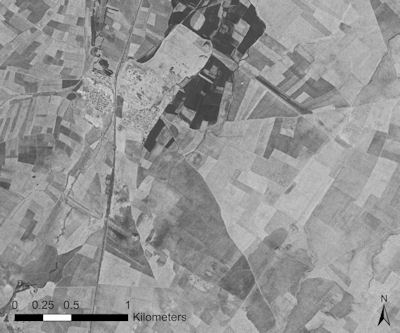
Figure 38: Khorsabad, Tigris River, northern Iraq [CORONA atlas]
© Internet Archaeology/Author(s)
University of York legal statements | Terms and Conditions
| File last updated: Fri Sept 21 2012